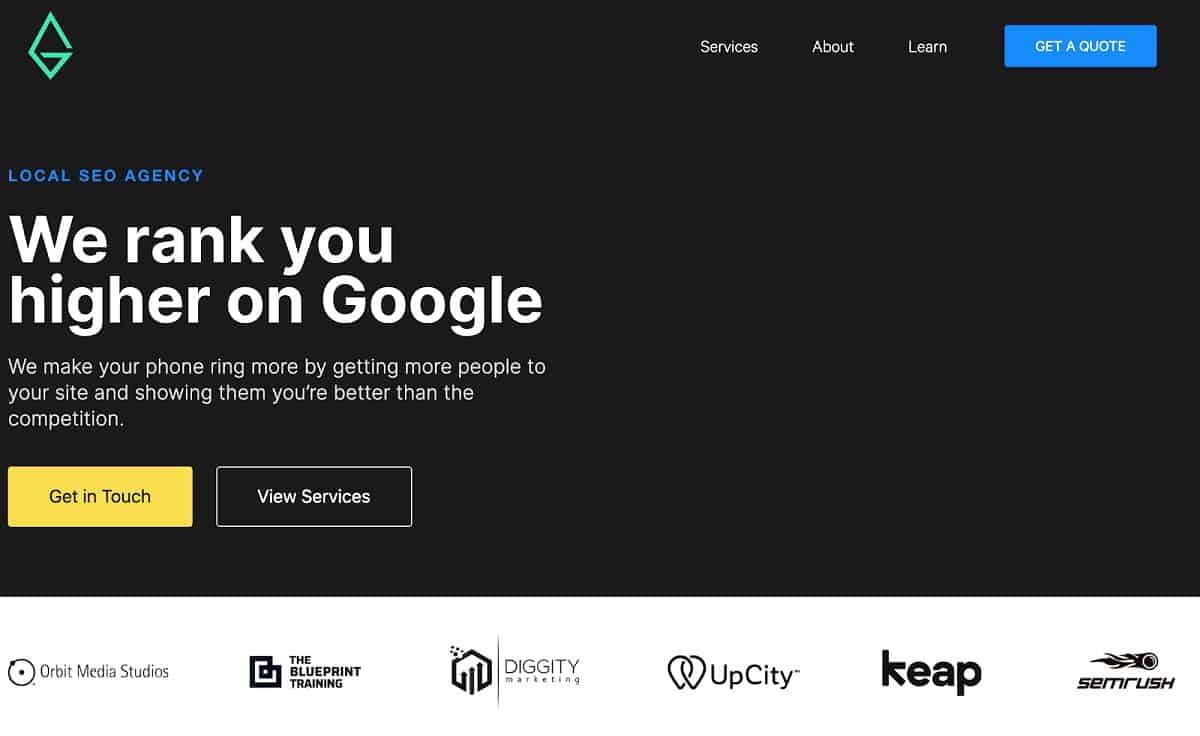8 Affiliate Marketing Strategies for Explosive Income Growth
Our readers always come first
The content on DollarSprout includes links to our advertising partners. When you read our content and click on one of our partners’ links, and then decide to complete an offer — whether it’s downloading an app, opening an account, or some other action — we may earn a commission from that advertiser, at no extra cost to you.
Our ultimate goal is to educate and inform, not lure you into signing up for certain offers. Compensation from our partners may impact what products we cover and where they appear on the site, but does not have any impact on the objectivity of our reviews or advice.
What makes some affiliate marketing businesses pop while others flop? It all comes down to having the right strategies. If you can target your audience, keywords, and SEO strategies correctly, you can make a significant monthly income with affiliate marketing.

Our mission at DollarSprout is to help readers improve their financial lives, and we regularly partner with companies that share that same vision. If a purchase or signup is made through one of our Partners’ links, we may receive compensation for the referral. Learn more here.
Rumor has it that affiliate marketing is dead.
Tell that to Jenny Weg, who makes $2,000 a month with her mom blog. Or Stacy Caprio, a millennial blogger who makes $2,700+ a month with her online deal site. Or even me, as someone who makes over $75,000+ per month via affiliate programs.
With figures like that, it’s pretty clear that these successful affiliate marketers are still in high demand.
But what makes some affiliate marketing businesses pop while others flop?
It all comes down to acute marketing strategies. If you can target your audience, keywords, and SEO strategies correctly, you can still make a significant monthly income with affiliate marketing.
Why Do Successful Affiliate Marketers Need to Be Strategic?
Some successful affiliate marketers earn millions, while the poor performers make a pittance.
What’s the difference?
Your affiliate marketing strategy.
While it’s certainly possible to make money online right now, you’ve got stiff competition.
Consider top affiliate networks, Awin and ClickBank. Between these two platforms alone, you’re competing with 311K affiliates.
That’s before you even begin to consider every other affiliate program, like Rakuten, ShareaSale, Amazon Associates, and so on.
You need to be strategic about the affiliate products you pick, the ways you market them, and the audience you target. Otherwise, you’ll be chasing the same dollars (and keywords) as your competition.
Don’t try to go head to head with legacy brands ranking for keywords that are ultra-competitive.
Affiliate marketing works best when you niche down. Devise clear sales and growth marketing tactics that distinguish you from your competition and create a brand story.
Affiliate marketing is more of an SEO game than a simple monetization strategy.
Find a profitable affiliate niche that you can own and be known for. Then hustle, build your domain expertise, and develop your content and SEO strategy with affiliate revenue at the top of the list.
Remember, this is a numbers game; you’ll need a lot of impressions (or views) to generate high sales.
On average, it takes 352 impressions to get one sale. In this respect, you’ll need to supercharge visibility to drive organic traffic and clicks.
To achieve this, focus on search engine optimization (SEO), link building, and high-quality, affiliate-keyword-optimized blog posts.
8 Best Affiliate Marketing Strategies to Drive Massive Sales
If you’re looking to create more passive income from your online business, here are 8 tried-and-tested affiliate marketing strategies to up your game.
1. Pick a high-performing affiliate niche.
Not all affiliate and e-commerce product niches are created equally. Just because you have an interest in vintage Pez dispensers doesn’t mean there’s a market for massive affiliate sales.
Luckily, you don’t have to fly blind when it comes to finding a profitable affiliate niche. Start by joining a reputable affiliate network and analyze which niches are most profitable.
Remember, the goal is to drive repeat purchases so your PayPal notifications roll in 24-7, even as you sleep.
Use an affiliate network to search for high-paying affiliate marketing programs based on two main factors: commission rates and cookie duration. The commission rate is the percentage (or cut) you make from each sale. Cookie duration is the length of time after a user clicks one of your affiliate links that you get credit for that sale. For example, if your cookie duration is 24 hours, then you can earn a commission as long as someone makes a purchase within 24 hours of clicking your link.
Additionally, if the company you’re promoting offers a monthly subscription (like a subscription box or SaaS company), then after you generate a sale, your affiliate commissions can be recurring. In this case, you get paid every month for as long as they remain a customer.
Let’s look at one of the top affiliate networks, ClickBank, for example.
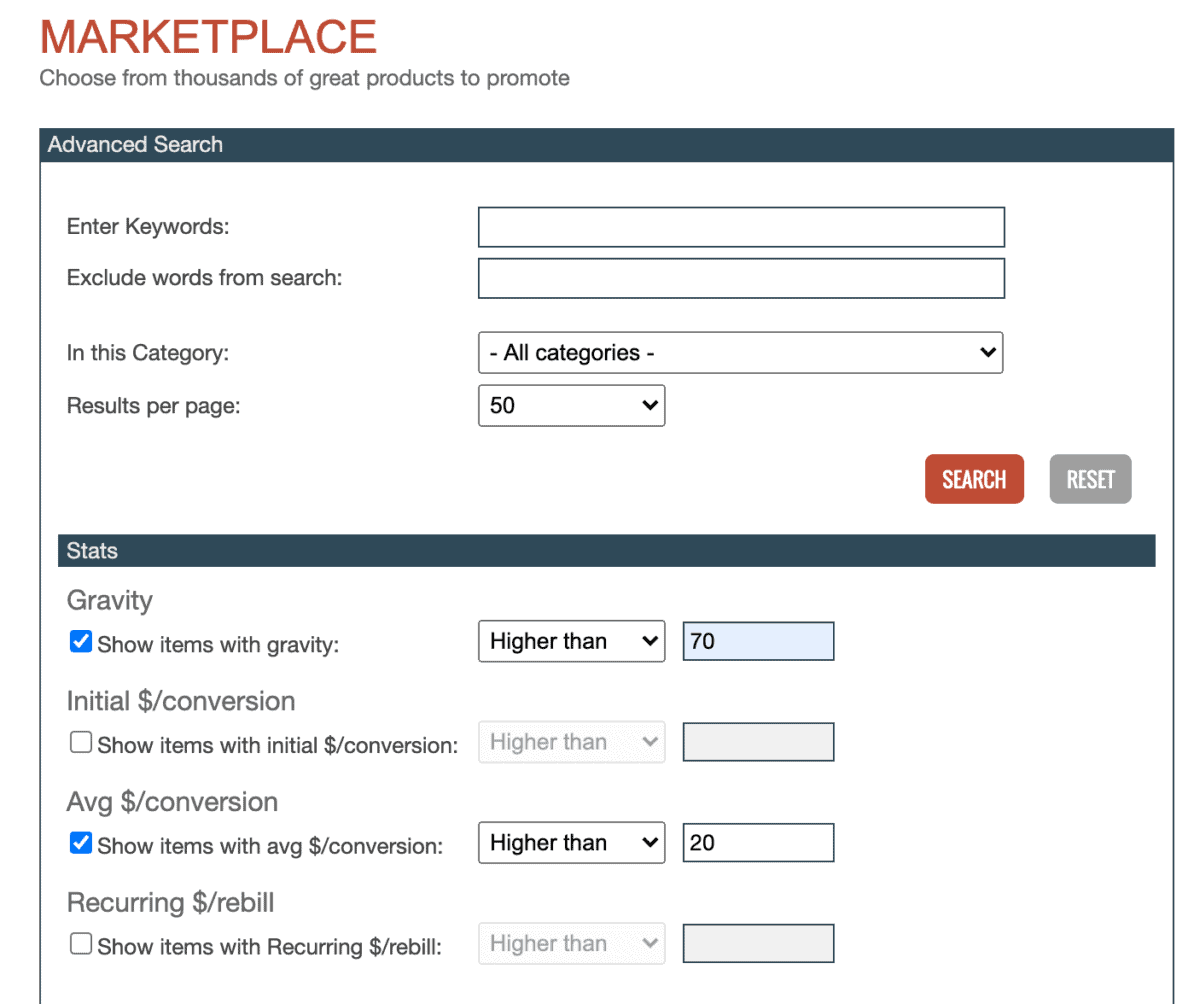
To find profitable niches, you head to the advanced search section of the Affiliate Marketplace.
The best affiliate niches on this affiliate platform have the highest Gravity score and the highest average profit per conversion.
Note: On ClickBank, the Gravity score refers to how many sales a product has had over a 12-week period. One sale equals a score of ‘1’, so a Gravity score of 70 would mean at least 70 affiliates have made a sale with this product over the last 12 weeks. If no sales are made, the score reduces to zero over an 8-week timeslot. The maximum score you should promote is 100.

As you can see, the health and fitness niche comes up with strong numbers.
Remember, though, that competition can be killer. Rather than trying to battle your way to the top of a very popular and broad niche, you would drill down into the health and fitness sector.
Look at how The Good Men Project promotes profitable ClickBank health products.
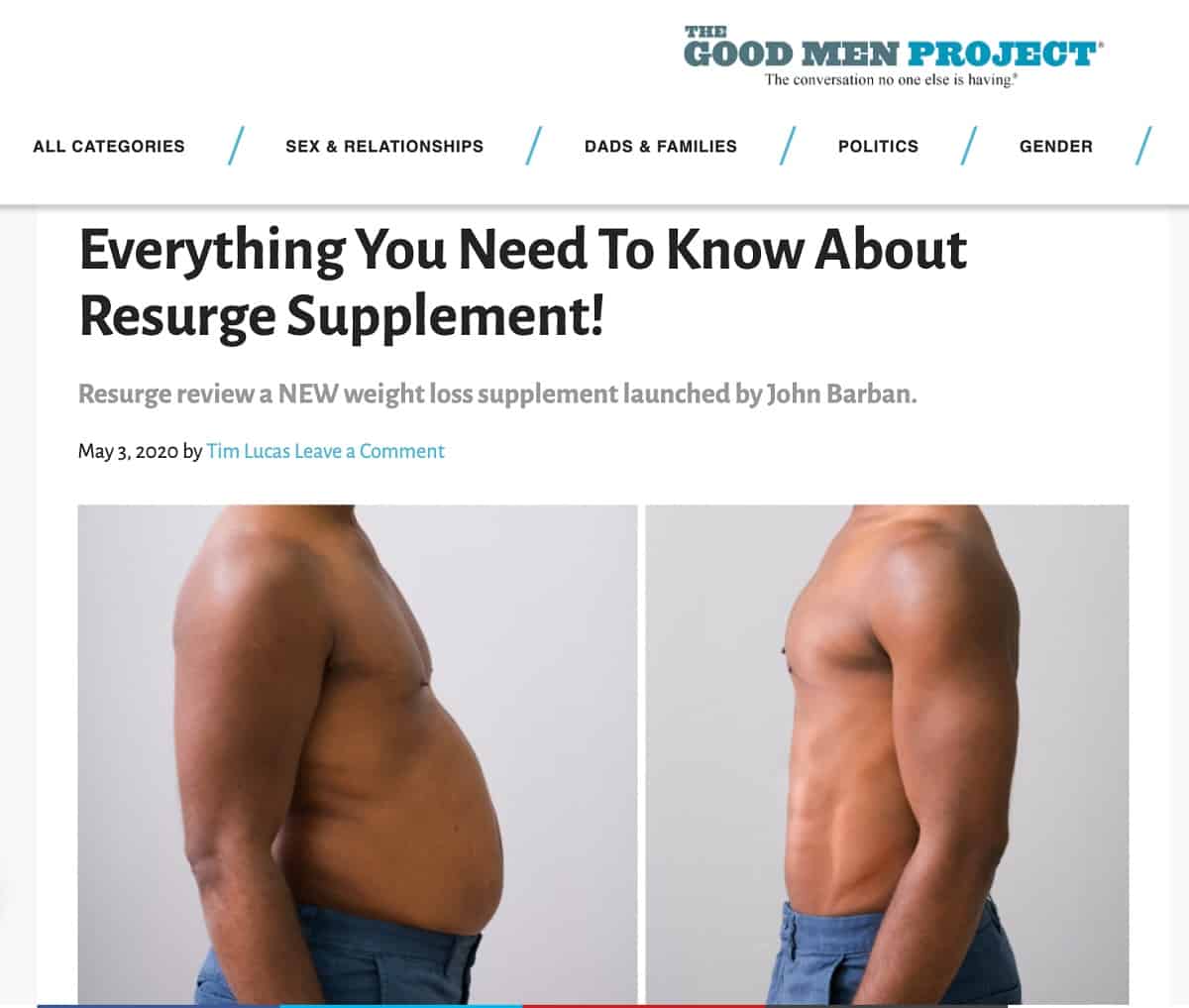
The Good Men Project has chosen the niche of ‘enlightened masculinity’, not health.
However, the blogging site still includes affiliate products from this lucrative niche to increase affiliate income.
Incorporating a health blog post into its content campaign, The Good Men Project drives traffic to the second-most profitable product on ClickBank — Resurge.
This is considered a product review post, one of the four main content types when it comes to affiliate marketing.
When you start your keyword research and content planning, make sure to incorporate these four types of affiliate-revenue-generating articles:
- How-to guides (i.e. how to build an email list)
- Listicles (i.e. best email marketing software)
- Product comparison (i.e. Mailchimp vs. Constant Contact)
- Product reviews (i.e. HubSpot review)
As you can see above, with the topic of email marketing, there are plenty of ways to capture traffic with different Google searches.
Related: 40 Blog Post Ideas and How to Generate Unlimited Blog Topics
2. Optimize your landing pages and blog posts.
Your landing pages are often the first impression that visitors get of your affiliate marketing business.
When building your website, be sure to optimize each landing page to encourage visitors to stay on your site and convert to a sale.
First off, let’s settle the age-old argument. What’s better, long or short copy?
The answer is neither. While, in many cases, longer blog posts are rewarded with better search rankings, you need to ensure your affiliate links are high up on the page.
For example, in my post on the best website builders, I include over 13 different options and make sure that each brand has at least three affiliate links in each section:
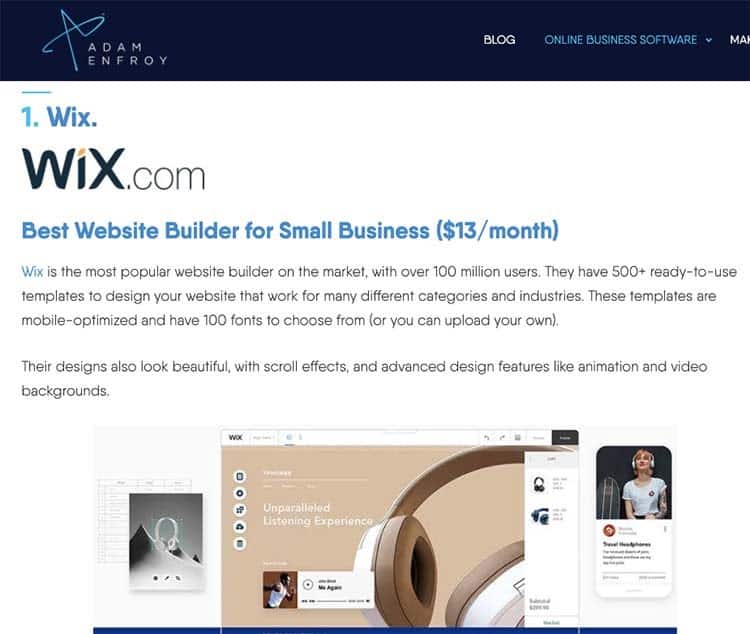
To analyze which elements are most effective on your website, you can also test out heatmaps and run A/B tests on various blog posts. Add and remove different elements to see how this affects overall conversions.
Firstly, notice that at the end of each company’s review in my post, all CTA links are shaped like buttons. This can increase conversion by 230%.
Secondly, some of the brands include discounts.
That’s because landing pages offering discounts of lower than 50% have average conversion rates of 10%. Once discounts reach 50% or higher, conversion rates start to climb. In fact, a 70% discount can lead to conversion rates of over 40%.
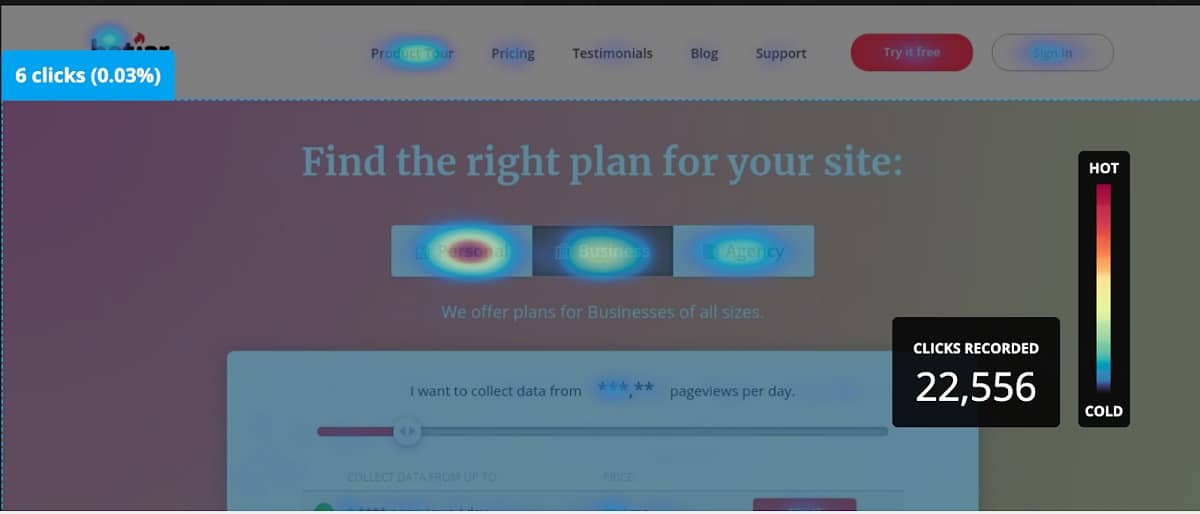
Next, find out which landing page elements get the most activity and how far visitors scroll by using a heat map tool.

And remember, slow-loading landing pages lose traffic. Make sure your landing page loads in under five seconds. One second longer and your bounce rate increases by 16%.
Finally, you can use a WordPress plugin like ThirstyAffiliates to track all of your affiliate links in one place, view reports, and track your clicks and earnings.
Related: How to Make Money Blogging
3. Develop a comprehensive SEO-driven keyword strategy.
To drive organic traffic, you need to appear at the top of Google’s search rankings as 50% of all traffic goes to the top Google search result.
Your keyword strategy is a strong influencing factor on how high you’ll appear up Google’s search rankings. If you want to drive high organic traffic to your affiliate site, your keyword strategy needs to be on point.
You’ll need to insert relevant search terms into your website content so Google can rank your pages for these keywords.
Affiliate bloggers should find it pretty easy to reach optimum keyword density. Add relevant keywords into high-quality content that’s relevant to your target audience. Then, run it through a keyword optimization tool like Marketmuse to add semantic keywords.
Overall, each blog post needs to focus on one target keyword, which should be included in:
- The title (or H1) of the post.
- The URL string (or slug).
- Within H2 headings.
- Throughout the content and in one of the first few paragraphs.
However, you need to be strategic about the keywords that you choose.
Ninety-two percent of keywords get less than ten searches a month. These key search terms won’t drive high traffic to your site. That said, you don’t want to pick keywords that have too much competition as you’ll struggle to beat top performers to the coveted number one spot.
Perform a keyword audit of your website to identify popular search terms to shape your keyword strategy.
Look for search terms with strong monthly search volume and low competition.
You can also use a tool like Ahrefs to view your competition and the current top 10 ranking sites for a particular keyword. Based on this data, check each site’s Domain Rating (DR) and URL Rating (UR) to see how authoritative their high-ranking pages are. If you notice that, for a given keyword, every site in the top 10 results has a 75+ DR and hundreds of links, it will be very hard to compete.
Alternatively, the hidden gems are the keywords that have at least one low DR site (under 60) ranking in the top 10 results. That means that with high-quality content and a few links, you might be able to start ranking for that keyword relatively quickly.
Also, don’t overlook long-tail keywords. If you find that your relevant short keywords are super competitive, try looking for search terms with multiple word variants. Over half of all keywords with between 1,000 and 10,000 monthly searches have three to five words.
Believe me when I say it pays off to become an expert in SEO, and the results will pay off in a big way in the months and years ahead.
Each piece of content is like an investment — and if you make smart investments in your content strategy, you can earn affiliate income for years to come. But content isn’t enough, you also need links.
4. Work on link building.
Internal links and backlinks show Google that you have authority in your niche topic, pushing you further up search rankings. In fact, 71% of online marketing specialists agree that Google relies heavily on your website’s link graph to rank your pages.
Content marketing is the top way to generate links, with 75% of marketers using this technique today.
There is a direct correlation between high-quality backlinks and a site’s ability to rank on search engines. If you look at my blog’s Ahrefs profile, you can see that organic traffic has increased substantially. This is a result of high-quality content and the large increase in referring domains and backlinks to my blog:
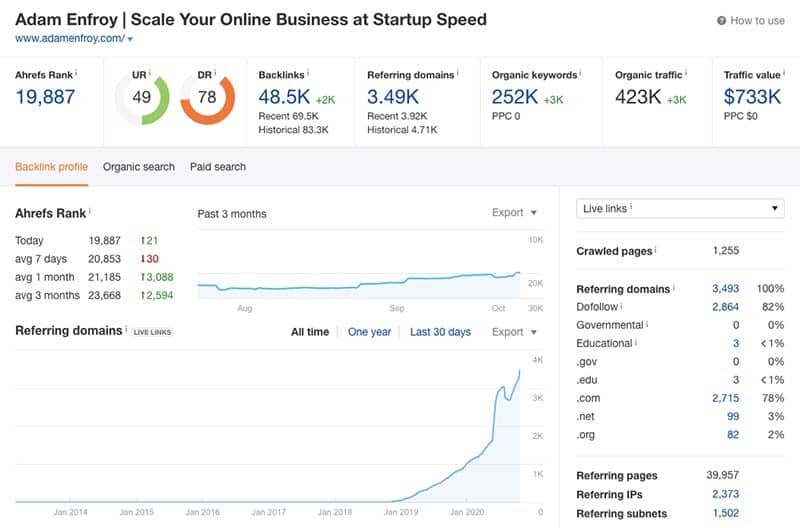
The more backlinks you have, the more traffic you’re likely to get, as there are more referring sources leading to your affiliate site.
Links are like the currency of the Internet and prove your authority in Google’s eyes. After all, wouldn’t the best content be linked to the most?
There are many different approaches and strategies one can take to link building, such as link building outreach, guest blogging, and creating link partnerships. Ultimately, it comes down to building real relationships with other sites in your niche.
Affiliates are also in the driver’s seat to build great links from the brands they promote. It’s all about leverage. If you can start generating big sales for a particular brand (or even just added them to a high-ranking post of yours), reach out to them and ask for a link or guest post. By providing value to them in the form of sales, they can provide value to you in the form of a link, which increases your Domain Authority (DA) and traffic.
5. Harness social proof.
Social proof refers to the strategies you use to show your buyers that you and your products are trustworthy.
Since 92% of consumers read product reviews before purchasing, this is one of the most important methods of social proof. Customers expect to see how well your products perform before they consider buying.
What’s more, as product reviews are user-generated, they’re a super cost-effective online marketing tactic. Try asking for product reviews from niche influencers in your field to boost your social standing.
Trust badges are another popular form of social proof that can push conversions by 32%. Pin awards, certifications, recognizable client logos, and other indicators of success to your product and landing pages.
Look at how Ardent Growth uses trust badges to capture attention above the fold.
By placing recognizable client logos above the fold, Ardent Growth immediately shows prospective customers how trustworthy its services are. It’s like saying “If SEMrush trusts us to produce SEO results, so should you.”
6. Use pop-ups for lead generation.
When a prospective customer hits your affiliate website, you need to move them down the sales funnel toward a conversion.
Top of the funnel (TOFU) marketing tactics bring customers to your website — think quality content, social media posts, and pay-per-click (PPC) advertising. Once there, you need to convert these customers before they leave.
If you have no way to collect customer data, you only have one shot to move these customers through the funnel before they click off your website.
Lead generation pop-ups capture customer data for future digital marketing campaigns. That way, if a customer doesn’t convert the first time, you can move them through the sales funnel later with sales calls and email campaigns.
To encourage more people to submit their data:
- Include images on your pop-ups
- Set pop-ups to trigger when customers have scrolled 35% of the page
- Add a countdown timer
- Use a multi-step sign-up process
- Optimize pop-ups for mobile
While on-page email opt-in forms can work too, exit-intent pop-ups are where it’s at. With exit-intent, you’re showing your pop-up to every single visitor before they leave. They don’t have to search your site to find your opt-in form; it appears at the time of your choosing. My blog gets over 90% of its email list growth from well-timed exit-intent pop-ups with a strong lead magnet.
7. Create personalized campaigns for each segmented email list.
Once a user opts into your email list, they should be filtered to the correct email sequence and provided with an automated welcome email series.
Ask questions at the lead generation stage to direct leads to the right email list. Use email marketing tools to send personalized emails that reflect these choices.
Half of online marketing experts personalize product recommendations to different audience segments, as 91% of customers are more likely to purchase when they’re offered relevant recommendations.
If you’re sending remarketing emails, best practice dictates that if a customer leaves without purchasing, you should send three remarketing emails — one within the hour, one within 24 hours, and one a week later. Try recommending similar products or offering a promotion to encourage conversions.
Your email funnel should ultimately sell a high-ticket product, but until then, your emails are another great place to add affiliate links. Some ideas for affiliate emails include:
- Product of the month
- How-to guides (with a product needed to complete the task)
- Special discounts and promos
A well-engaged email list can increase your affiliate sales in a big way. Don’t forget to include an affiliate disclaimer in your emails so that your readers know your relationship with the brands you’re promoting.
8. Offer targeted discounts and promotions.
Promotional marketing can boost conversion rates by 522%. And this is true in the affiliate world, too.
Since more than three-quarters of shoppers consider discounts to be a deal clincher, it’s a wise idea to have strategic promotional marketing in place.
Think beyond basic money-off promotions to target offers to your different audience segments.
Fifty-three percent of shoppers say they want relevant offers based on their purchasing habits. Try to work out what sells well with which demographic, and target them accordingly.
After you sign up for an affiliate program, reach out to the program’s affiliate manager and see if they can send you a custom coupon for your audience. If you can get your readers 10, 20 or even 30% off, use that incentive to increase your affiliate conversion rates.
Affiliate Marketing Strategies Fit Into Four Stages
With these tried-and-true affiliate marketing strategies under your belt, you’ll begin to see an uplift in clicks, conversions, and commissions.
Driving affiliate revenue is a four-act play:
- Improve your visibility on Google with creative SEO techniques.
- Optimize your web pages to encourage on-page conversions.
- Capture data for ongoing digital marketing.
- Analyze your affiliate marketing campaigns to see which work the best.
All of these tactics must work in unison. Your keyword and SEO strategy needs to plan for future monetization. Your content needs to be both high-quality and optimized for affiliate links. And you need to build strong partnerships (and links) with other blogs in your niche and the brands you promote.
It’s a hard-earned mix of well-written content, relationship building, hard work, know-how, and a hustle mindset. If you get it right, you just might be able to ditch the 9-to-5 and become a full-time affiliate marketer.

